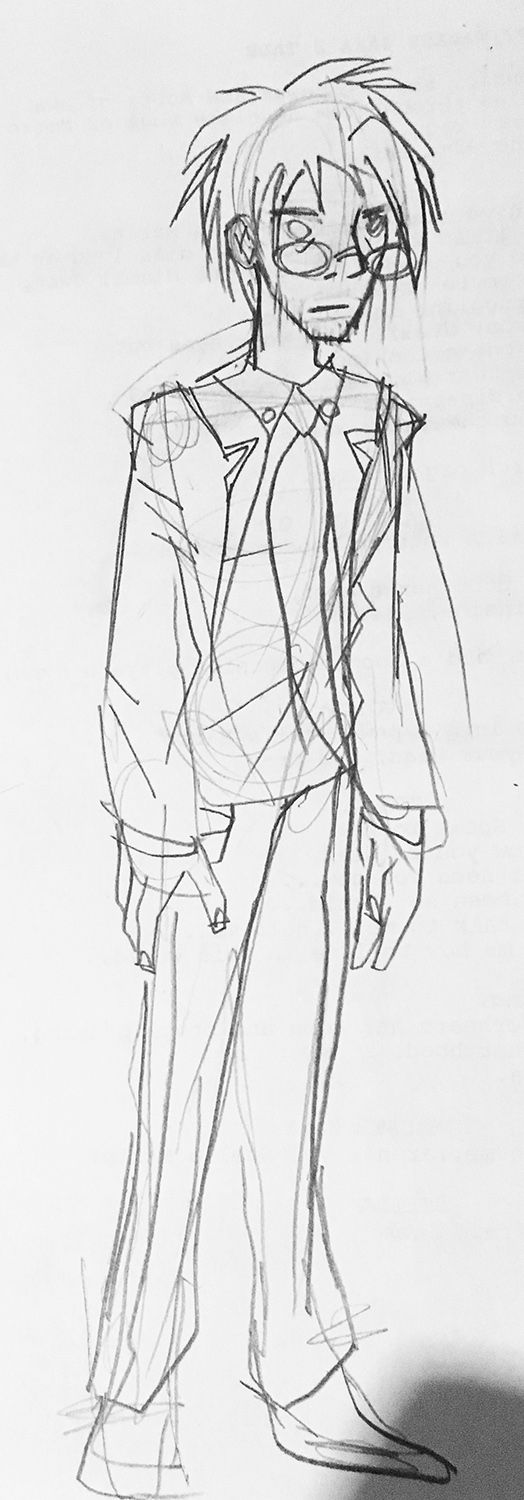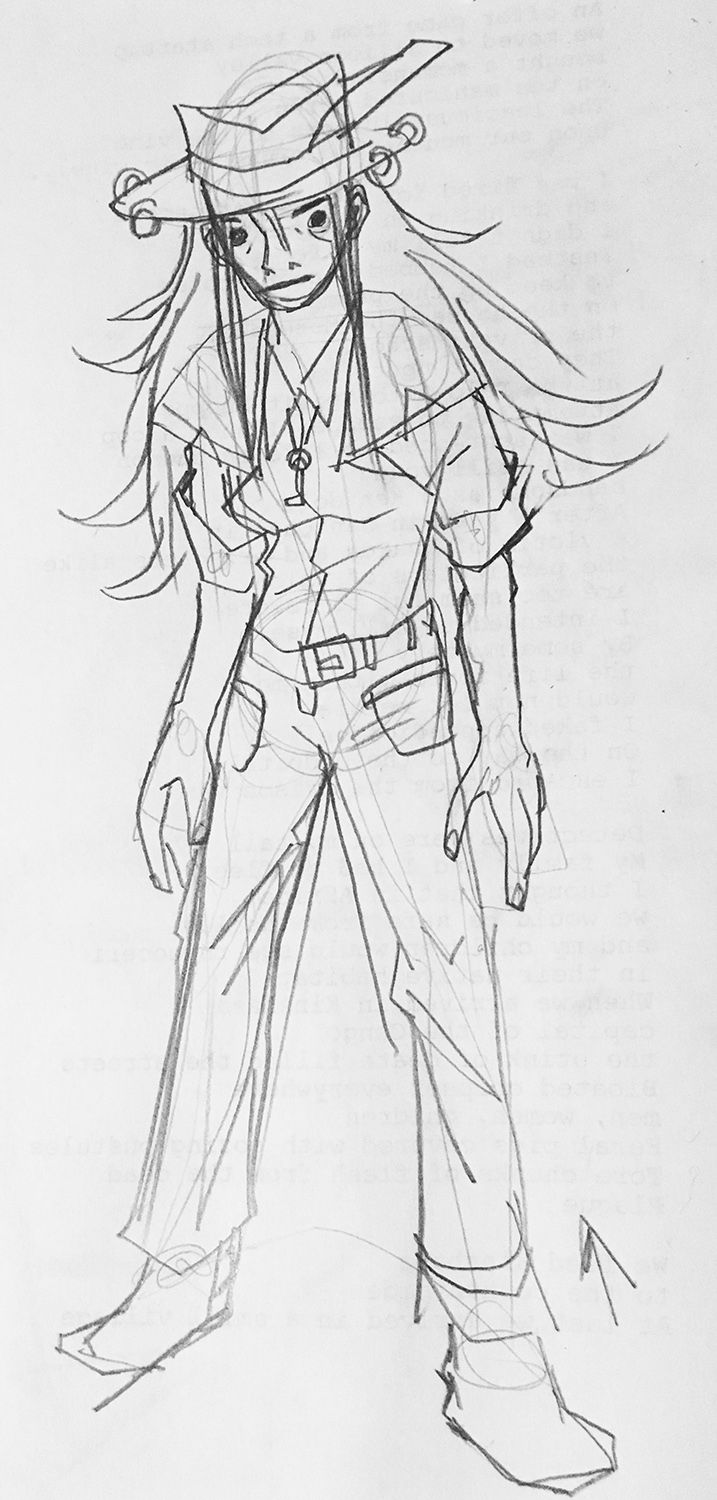


STORY
The story of Pageturner really is complete. There isn't anything more I want to explore with the characters. While I do wish I'd gotten to flesh them out more in this game (I had to keep the script tight, because of engine limitations) I'm happy with where they ended up.
The script underwent some changes when I restarted production. The original game was pretty tepid — Benedict just got a police badge, the end. I wasn't trying to do anything special with the story, since the point was to return the focus to the mystery.
After seeing cops beating up people in wheelchairs, children, and pepper spraying and driving into protestors, that old version of the story had to go. It was too close to being a "heroic cop" narrative, which is not reflective of the real world at all.
"Corruption" is sort of a symbol for not just the corruption, but the other, heavier problems associated with police that wouldn't fit the tone of the story and probably wouldn't be appropriate for a Scratch game (I was already stretching it a bit by making it a murder mystery...)
With more time to develop that aspect of the story, I could've done a better job writing it, but hopefully my intentions were conveyed. And seeing as I make a lot of crime/mystery games, I'm sure I'll have a chance to revisit this topic.

CHARACTER DESIGNS
This game had waaaay more characters in it, on account of having fourteen suspects during the interrogation sections. Coming up with each character was pretty fun.
On top of that, there were new designs for May and Benedict, the police station characters (Arctica, Daniel, Variola and Scammy), and designs of older versions of them for the ending. So in total I had to design twenty-one characters.

It's always tricky to age up a character. A lot can change as you get older, but if too much changes, it doesn't seem like the same person anymore. Since Benedict's hair is the most recognizable aspect of him, I kept it the same.

I decided that May changed a whole lot, and her hair turned completely silver prematurely. It created more of a contrast.

A great trio of characters! Blythe was lots of fun to write, I'm very happy with how Victor turned out, and so was John Quite.

It's always tricky to age up a character. A lot can change as you get older, but if too much changes, it doesn't seem like the same person anymore. Since Benedict's hair is the most recognizable aspect of him, I kept it the same.

MUSIC
When I started up production again, I'd just finished working on Methods, which also features a jazz-influenced soundtrack, so my main concern was making sure I didn't do anything too similar. Fortunately, I'd completed around five tracks already that were super helpful in figuring out where to go. I knew piano would be the featured instrument, because I'd said that in a Games Update a while back, so I basically just noodled around in the Blues scale on a piano — that was the starting point for most of the tracks.
I also noticed that the old tracks featured electric guitar as well, so I used that as an unexpected element. When I try to come up with a track for a game I'm always thinking about how the track relates to the other tracks I've already made, and what new, unique or exciting elements I can add.
Sometimes that's a rhythm I haven't used before, or a new instrument, or some fancy trick like switching signatures or slowing down the tempo. One of the more interesting sounds I used was an electric guitar put through a Bitcrusher (on the track "Shauna").
My favorite track is "Police Station", which I actually made back in 2018.

BACKGROUNDS
I had a pretty big head start on the backgrounds, because I'd gotten basically most of them done back in 2018. The hardest background to make was the second floor with the cubicles — and I'd already done that one. The new backgrounds are the interrogation room, basement, the break room, Shauna's house, May's new office... so not too much to handle within my weekly deadline.
But I did end up re-rendering most of them to add better lighting. One of the more fun locations to make was the Kidz Zone. I like how incongruous it is.
In order to make the backgrounds, they needed to start with a strong concept — I knew Shauna's house was going to have an open floor plan from the start, which also suggested very bright, sunny lighting. I like to texture the model as I go — it's an unconventional thing to do, but it helps me coordinate the colors better. Also, I find it tedious to go back in to something that's been completely modeled and texture it.

The first time I showed May's office, back when I announced the game, I hadn't lit it very well.

As you can see, May's office got a big upgrade once I decided not to fake the light streaming into the window after all.

The final background in the game! It's still a bit small, but less cramped than May's old office. I spent a lot of time on detail work. It's a personal motto of mine never to use placeholder text, so those flyers by the window that you can't even see the text on? Yeah, they have text.

The first time I showed May's office, back when I announced the game, I hadn't lit it very well.

CODING
There is a bit of code that I'm actually proud of, though if you look in the project you'll see that most of it is extremely sloppy. The dialogue system in the new Pageturner 3 is so much better.
I have a variable for who is talking that all the character sprites are aware of. Because there is never simultaneous dialogue, I just have every character except the one talking close their mouths.
The dialogue portrait is separate from the text and also makes use of this variable to switch to the correct portrait.
The variable itself is set within the dialogue text sprite, by making use of "costume name", I just write who's talking in the name of the costume of the dialogue, plus the costume number, and it extracts that and sets this variable for me.
The result of this is that I no longer had to have huuuge long chains where I was using broadcasts to tell a character to open their mouths after switching to their line of dialogue — that was how it worked in Pageturner 2.
And the dialogue costumes no longer needed to contain the character portraits.
Now this may seem like a total no-brainer, but I'm really not the best at coding, even with something very simple like Scratch. Hopefully someone reading this finds this useful.
The node game was a rather painful thing to code but I managed to get it done in the end, and it is a vast improvement over Pageturner 2's, in my opinion.
For one, I made heavy use of cloning, a bit risky since I still am not 100% sure I'm doing it correctly? But in any case, it works thankfully. I no longer have like 30 sprites of different nodes.
In the years since I released Pageturner 2, I got ton of comments asking me what the answer to a certain node game puzzle is, or what certain plugs did. I realized that it just wasn't clear enough — the information about the plugs was hidden in a menu that was hard to find if you didn't pay enough attention during the tutorial.
Initially, I wanted to do something very involved where you would actually see an animated scenario of what the plugs did, but it just wasn't worth the effort. I decided to label the plugs, but I didn't want to clog up the nice UI with a bunch of labels everywhere, so instead I made it so the label only appears if you're hovering over the plugs — I think it works great.
To fix the other problem, I added a hint system as well.
Graphically, the node game is much more streamlined. There was a lot of empty space on those old nodes, and the circles look better in my opinion.
All the UI for the game was made by exporting Adobe Animate CC files as SVGs and then importing them into Scratch, which is how I achieved a "brush" texture.



CONCLUSION
The Final Nail is the subtitle of Pageturner 3 — and it means that this is truly the "final nail in the coffin" for the series.
I think three games and a comic is pretty solid. And what's nice is that all of that content can be experienced on Scratch. Scratch is simply not built to tell dialogue-heavy stories like Pageturner. Implementing the dialogue was mostly frustrating, even with the better dialogue system.
Once the script was pasted in, I was unable to change anything about it, as each costume name has to include the costume number, so I would need to retype hundreds of costume names if I made a revision. And with every hundred lines of dialogue, it would get slower and slower to work with.
That's not even mentioning the time Scratch glitched and I almost lost weeks of work — good thing I was making regular back-ups!
I don't mean to sound all doom and gloom about Scratch. While it was occasionally very frustrating, I did grow to love the new features in 3.0.
Being able to trigger events when the backdrop changes? Great! Improved sound quality and editor? Great! Costume name block? THANK YOU!!! Greatest of all — no more megabyte limit! I was truly able to put as many fancy graphics in the game as I wanted to, which is why the file is so incredibly large and most people probably can't even load the game.
Pageturner 3 took about five months to complete, but that's not counting all the work I did on it prior to this year. I'd already set up a lot of stuff — the main menu, lots of sprites, how the scenes would work, the copier minigame, the majority of the music tracks, and of course I'd already written one and a half chapters. I'd estimate that considering that, it took maybe eight months. That's probably surprising seeing how short the game is to play, but that's just how it is — these things take a lot of time.
I kept pretty much all of the previous work I'd done on it. I did end up redrawing May and Arctica's bodies, had to revise the writing a bit, and a few things like that, but it's really very close to what my initial vision for it was.
I hope you enjoyed the game, and took the time to find the secrets — the final secret is particularly rewarding I think.


